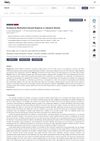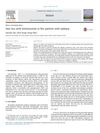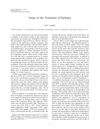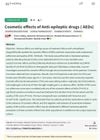TLDR Many pediatric epilepsy patients experience preventable severe adverse drug reactions, especially with certain medications and risk factors.
The study analyzed adverse drug reactions (ADRs) in 315 pediatric epilepsy patients over 112 months, identifying 548 ADRs in 211 patients. The most frequent ADRs were drowsiness, irritability, thrombocytopenia, and alopecia, primarily associated with valproic acid (VPA), levetiracetam (LEV), and phenytoin (PHT). Polytherapy and younger age were significant risk factors for ADRs, with malnutrition also contributing to severe ADRs. LEV and oxcarbazepine (OXC) caused more non-severe ADRs, while PHT caused more severe ADRs. Notably, most severe ADRs were preventable, highlighting the importance of intensive pharmacovigilance in improving medication safety in pediatric patients.
 3 citations
,
June 2023 in “Medicines”
3 citations
,
June 2023 in “Medicines” Some antiseizure medications can cause reversible hair loss, with valproate, lamotrigine, and carbamazepine being the most common.
 13 citations
,
November 2013 in “Seizure: European Journal of Epilepsy”
13 citations
,
November 2013 in “Seizure: European Journal of Epilepsy” Levetiracetam may cause hair loss, which can potentially reverse with lower doses or stopping the drug.
36 citations
,
October 2008 in “European journal of paediatric neurology” Valproic acid treatment may cause temporary hair loss due to reduced zinc and biotinidase levels, which tend to normalize after 6 months.
 4 citations
,
August 2001 in “Epilepsia”
4 citations
,
August 2001 in “Epilepsia” Treating epilepsy is complex, requiring careful drug choice and patient adherence to manage seizures and side effects.
7 citations
,
May 2021 in “Seizure” Some antiseizure medications can cause cosmetic problems like hair loss, excessive hair growth, acne, and gum overgrowth.
 January 2024 in “Authorea (Authorea)”
January 2024 in “Authorea (Authorea)” Antiepileptic drugs cause cosmetic side effects like hair loss and weight gain, but patients still take their medication without it affecting their quality of life.
 13 citations
,
November 2013 in “Seizure: European Journal of Epilepsy”
13 citations
,
November 2013 in “Seizure: European Journal of Epilepsy” Levetiracetam may cause hair loss, which can potentially reverse with lower doses or stopping the drug.
 3 citations
,
June 2023 in “Medicines”
3 citations
,
June 2023 in “Medicines” Some antiseizure medications can cause reversible hair loss, with valproate, lamotrigine, and carbamazepine being the most common.



